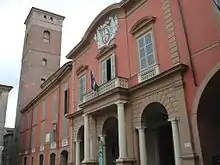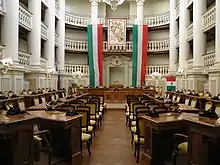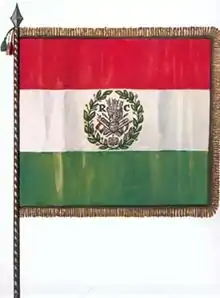Sala del Tricolore
The Sala del Tricolore (Italian for "Room of the Tricolor"), former Patriotic Hall, is an historical hall, currently the council chamber of the comune of Reggio Emilia, northern Italy. Designed by the architect Lodovico Bolognini, as the archive of the ducal family of Este, it is mostly known in connection with the birth of the flag of Italy (also known as "the tricolor"), from which it takes its name.

Description


The palace
The Sala del Tricolore is located within the town hall of Reggio Emilia. The palace was built from 1414 to 1417.[1] It began to be used as a meeting room of the municipal council of Reggio Emilia in 1434.[2] It was enlarged in 1461 with the construction of the wing towards the modern via Farini and via Croce Bianca: this portion of the building also had an external loggia.[2] In the following years the building was enlarged again.[2] In 1583 Prospero Pacchioni designed and carried out his complete renovation.[1] The building's facade was built in 1774 to a design by Ludovico Bolognini.[2]
The Sala del Tricolore
The room looks like an elliptical room, surrounded by three rows of balconies.[3] There is a large chandelier that illuminates a neoclassical architectural style environment; the latter is characterized by columns with Corinthian capitals on top.[4]
The hall has the function of council chamber of the municipality of Reggio Emilia: therefore it is used for meetings of the municipal council of the city.[2] It also houses the civic gonfalone of the municipality of Reggio Emilia.[2]
It is also used for cultural events, conferences and weddings, as well as for the annual commemorative ceremony for the anniversary of the birth of the Italian national flag, which takes place every January 7 on the occasion of the Tricolour Day, in the presence of the highest offices of the Italian Republic.[2]
On March 16, 2015 the "Sala del Tricolore" hosted an important young political event for Emilia-Romagna and the city: the opening ceremony of the XV Regional Session of the Model European Parliament, hosting delegations from the host city, Ferrara, Mirandola, Modena, Carpi, Cento and Prato; the mayor Luca Vecchi, the MEP president Andrea Russo and other authorities opened the session to a full Sala del Tricolore.
History
The origins of the Sala del Tricolore
The origins of this salon date back to 1768, when the Duke of Modena and Reggio Francesco III d'Este decided to have a central state archive built that should have kept all the documents of the Duchy of Modena and Reggio.[5] The architect's choice to entrust the drafting of the project and the construction of the new hall fell on Lodovico Bolognini, who then carried out the work from 1772 to 1785.[5]
During the construction works Giovanni Benassi, court carpenter, always under the supervision of Bolognini, built from 1773 to 1774 a wooden model of the hall which lacked, compared to the modern version, the balconies: in their place were provided shelving for the preservation of documents, which were accessed via wooden ramparts.[5]
Shortly after the end of the works it was decided not to use it as a file: the large quantity of documents contained in it could have caused a vast fire, with all the consequences of the case.[5] To decide the intended use of the hall, the ducal archive was rejected, a commission was established.[5] This consultation proposed, among other things, its splitting up into several rooms to be used as offices but the duke opposed him postponing his decision.[5]
The birth of the flag of Italy


With the invasion of Napoleon's troops the duke fled and the Reggian Republic was proclaimed (26 August 1796).[5] At the same time the Civic Guard of the city of Reggio was constituted: this military formation, aided by a small group of French grenadiers, defeated, on 4 October 1796, a squad of 150 Austrian soldiers at Montechiarugolo, a municipality in the modern province of Parma.[5] The victory was so important - both from a political and symbolic point of view - that Napoleon Bonaparte made an official commendation to the Reggio soldiers who were the protagonists of the battle.[6] For the armed clash of Montechiarugolo Napoleon Bonaparte defined the city of Reggio Emilia as "the most mature Italian city for freedom".[7]
Moreover, in Reggio Emilia, in August 1796, one of the first liberty pole had been planted.[7] This events, which arose from a revolt against the ducal government on August 20, 1796 in Reggio, contributed, together with the events linked to the battle of Montechiarugolo, to the decision to choose Reggio Emilia as the venue for the congress cispadano, assembly that then led to the birth of the flag of Italy.[7]
As a symbolic recognition of the Montechiarugolo clash, and for the aforementioned event related to the tree of liberty, Napoleon suggested to the deputies of the Cispadan cities (Reggio, Modena, Bologna and Ferrara) to gather their first congress - which should have taken place on 27 December 1796 - in Reggio Emilia.[8]
The proposal was followed despite heated controversy with the other cities of Emilia, which wanted the assembly organized in their own municipality;[7] the congress of December 27 took place then in the hall of the Reggio town hall designed by Bolognini which was to house the archive of the former duchy.[9] Here, 110 delegates chaired by Carlo Facci approved the constitutional charter of the Cispadane Republic, including the territories of Bologna, Ferrara, Modena and Reggio Emilia.[10][11] For this reason the salon of the Bolognini was renamed "centumvirate congress hall" or "patriotic hall".[9]

In subsequent meetings, which always took place in the "hall of the congress centumvirate" of Reggio, many decisions were decreed and formalized, including the choice of the emblem of the newly formed republic.[12] To put forward the proposal for the adoption of a green, white and red national flag was Giuseppe Compagnoni - who for this reason is remembered as the "father of the Italian flag" - in the XIV session of the congress cispadano[13] of 7 January 1797.[12][14][15] The adoption decree states:[13][16][17]
[...] From the minutes of the XIV Session of the Cispadan Congress: Reggio Emilia, 7 January 1797, 11 am. Patriotic Hall. The participants are 100, deputies of the populations of Bologna, Ferrara, Modena and Reggio Emilia. Giuseppe Compagnoni also motioned that the standard or Cispadan Flag of three colors, Green, White and Red, should be rendered Universal and that these three colors should also be used in the Cispadan Cockade, which should be worn by everyone. It is decreed. [...][18]
— Decree of adoption of the tricolor flag by the Cispadane Republic
The final choice of a green, white and red flag was not without a prior discussion: instead of the green the Italian Jacobins would have favored the blue of the French flag, while the members of the papacy would have preferred the yellow of the Papal States' banner: on the white and the red there were no disputes.[19] Finally, the discussion on the third color focused on green, which was later approved as a compromise solution.[19] The choice of greenery was most probably inspired by the tricolor green, white and red military flag of the Lombard Legion, the first Italian military department to equip itself, as a banner, with an Italian tricolor flag.[20]
The congress's decision to adopt a green, white and red tricolor flag was then also greeted by a jubilant atmosphere, so much was the enthusiasm of the delegates, and by bursts of applause.[21] For the first time, the city of ducal states for centuries enemies, they identify themselves as one people and a common identity symbol: the tricolor flag.[19]
For the first time the Italian flag officially became the national flag of a sovereign state, disengaging itself from the local military and civic meaning: with this adoption the Italian flag therefore assumed an important political value.[22][23] On the basis of this event, the "centumvirate congress hall" of Reggio was later renamed "Sala del Tricolore".[9]
In the assembly of 21 January, which was instead convened in Modena, the adoption of the Tricolor was confirmed. The flag of the Cispadane Republic was in horizontal bands with the top red, the white in the center and the green at the bottom. In the center was also the emblem of the republic, while on the sides the letters "R" and "C" were shown, the initials of the two words that form the name of the "Repubblica Cispadana".[14]
Citations
- "Palazzo comunale di Reggio Emilia" (in Italian). Retrieved 21 February 2017.
- "Sala del Tricolore" (in Italian). Retrieved 7 March 2017.
- Touring Club Italiano 2000, p. 42.
- "Info su Sala del Tricolore" (in Italian). Retrieved 7 March 2017.
- Busico 2005, p. 209.
- Busico 2005, pp. 209-210.
- Villa 2010, p. 45.
- Busico 2005, p. 210.
- Busico 2005, p. 10.
- Maiorino 2002, pp. 156-157.
- Fiorini 1897, pp. 704-705.
- Maiorino 2002, p. 157.
- "Origini della bandiera tricolore italiana" (PDF) (in Italian). Archived from the original (PDF) on 24 February 2017. Retrieved 2 March 2017.
- Vecchio 1999, p. 42.
- Tarozzi 1999, p. 9.
- Fiorini 1897, p. 706.
- Villa 2010, p. 46.
- [...] Dal verbale della Sessione XIV del Congresso Cispadano: Reggio Emilia, 7 gennaio 1797, ore 11. Sala Patriottica. Gli intervenuti sono 100, deputati delle popolazioni di Bologna, Ferrara, Modena e Reggio Emilia. Giuseppe Compagnoni fa pure mozione che si renda Universale lo Stendardo o Bandiera Cispadana di tre colori, Verde, Bianco e Rosso e che questi tre colori si usino anche nella Coccarda Cispadana, la quale debba portarsi da tutti. Viene decretato. [...]
- Villa 2010, p. 11.
- Villa 2010, p. 10.
- Maiorino 2002, p. 158.
- Busico 2005, p. 13.
- Maiorino 2002, p. 155.
References
- Reggio Emilia e provincia. I centri della pianura, il Po, le rocche dell'Appennino (in Italian). Touring Club Italiano. 2000. ISBN 8-836-5-158-51.
- Busico, Augusta (2005). Il tricolore: il simbolo la storia (in Italian). Presidenza del Consiglio dei Ministri, Dipartimento per l'informazione e l'editoria. SBN IT\ICCU\UBO\2771748.
- Fiorini, Vittorio (1897). "Le origini del tricolore italiano". Nuova Antologia di Scienze Lettere e Arti (in Italian). LXVII (fourth series): 239–267 and 676–710. SBN IT\ICCU\UBO\3928254.
- Maiorino, Tarquinio; Marchetti Tricamo, Giuseppe; Zagami, Andrea (2002). Il tricolore degli italiani. Storia avventurosa della nostra bandiera (in Italian). Arnoldo Mondadori Editore. ISBN 978-88-04-50946-2.
- Tarozzi, Fiorenza; Vecchio, Giorgio (1999). Gli italiani e il tricolore (in Italian). Il Mulino. ISBN 88-15-07163-6.
- Vecchio, Giorgio (2003). "Il tricolore". Almanacco della Repubblica (in Italian). Bruno Mondadori. pp. 42–55. ISBN 88-424-9499-2.
- Villa, Claudio (2010). I simboli della Repubblica: la bandiera tricolore, il canto degli italiani, l'emblema (in Italian). Comune di Vanzago. SBN IT\ICCU\LO1\1355389.
External links
| Wikimedia Commons has media related to Sala del Tricolore. |
- Sala del Tricolore at www.tricolore.it (in Italian)
